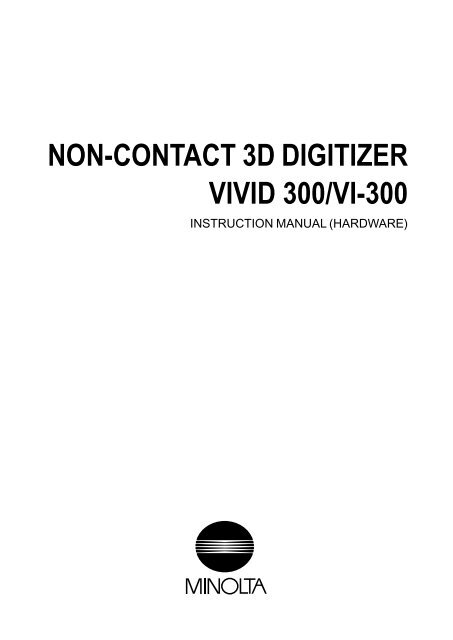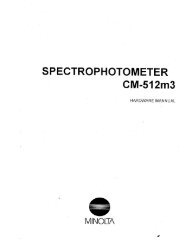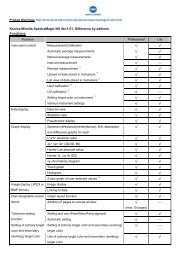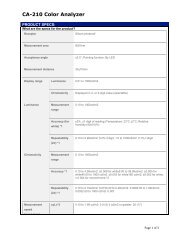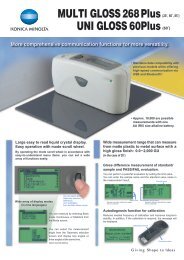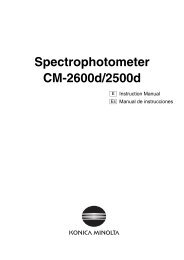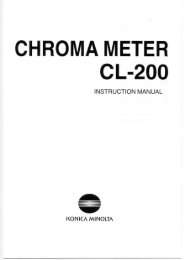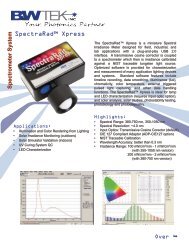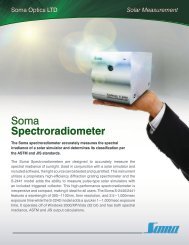Vivid 300 Manual - Konica Minolta Sensing Americas, Inc.
Vivid 300 Manual - Konica Minolta Sensing Americas, Inc.
Vivid 300 Manual - Konica Minolta Sensing Americas, Inc.
Create successful ePaper yourself
Turn your PDF publications into a flip-book with our unique Google optimized e-Paper software.
NON-CONTACT 3D DIGITIZER<br />
VIVID <strong>300</strong>/VI-<strong>300</strong><br />
INSTRUCTION MANUAL (HARDWARE)
Safety Symbols<br />
The following symbols are used in this manual to prevent accidents which may occur as result of<br />
incorrect use of the instrument.<br />
Denotes a sentence regarding safety warning or note.<br />
Read the sentence carefully to ensure safe and correct use.<br />
Denotes a prohibited operation.<br />
The operation must never been performed.<br />
Denotes an instruction.<br />
The instruction must be strictly adhered to.<br />
Denotes an instruction.<br />
Disconnect the AC power cord from the AC outlet.<br />
Denotes a prohibited operation.<br />
The part must never be disassembled.<br />
Denotes a sentence regarding safety precaution for laser.<br />
Read the sentence carefully to ensure safe and correct use.<br />
Denotes an instruction.<br />
Connect the grounding terminal as instructed.
SAFETY PRECAUTIONS<br />
• To ensure correct use of the VIVID <strong>300</strong>, read the following points carefully and adhere to them. After you have<br />
read this manual, keep it in a safe place where it can be referred to anytime a question arises.<br />
WARNING (Failure to adhere to the following points may result in death or serious injury.)<br />
Do not use the VIVID <strong>300</strong> in places where flammable<br />
or combustible gases (gasoline etc.) are present.<br />
Doing so may cause a fire.<br />
Always use the AC power cord supplied as a standard<br />
accessory with the VIVID <strong>300</strong>, and connect it to<br />
an AC outlet (100-240 Vac, 50-60 Hz). Failure to<br />
do so may damage the VIVID <strong>300</strong>, causing a fire or<br />
electric shock.<br />
Do not bend, twist or pull the AC power cord excessively.<br />
In addition, do not place heavy items on the<br />
AC power cord, or damage or modify it in any way.<br />
Doing so may cause damage to the AC power cord,<br />
resulting in fire or electric shock.<br />
If the VIVID <strong>300</strong> will not be used for a long time,<br />
disconnect the AC power cord from the AC outlet.<br />
Accumulated dirt or water on the prongs of the AC<br />
power cord’s plug may cause a fire. If there is any<br />
dirt or water on the prongs of the AC power cord’s<br />
plug, remove it.<br />
When disconnecting the AC power cord’s plug, always<br />
hold the plug and pull it to remove it. Never<br />
pull the AC power cord itself. Doing so may damage<br />
the AC power cord, causing a fire or electric<br />
shock. In addition, do not insert or disconnect the<br />
AC power cord’s plug with wet hands. Doing so<br />
may cause electric shock.<br />
The VIVID <strong>300</strong> should not be operated if it is damaged,<br />
or smoke or odd smells are detected. Doing<br />
so may result in a fire. In such situations, turn the<br />
power OFF immediately, disconnect the AC power<br />
cord from the AC outlet, and contact the nearest<br />
<strong>Minolta</strong>-authorized service facility.<br />
For Continued protection against risk of fire or electrical<br />
shock a mains plug shall connect to grounding-type<br />
socket outlet.<br />
Before connecting the grounding terminal, make<br />
sure that the AC power cord is not connected to the<br />
AC outlet. Failure to do observe this may cause<br />
electric shock.<br />
Do not place the VIVID <strong>300</strong> on an unstable or sloping<br />
surface. Doing so may result in its dropping or<br />
overturning, causing injury. Take care not to drop<br />
the VIVID <strong>300</strong> when carrying it.<br />
Do not disassemble or modify the VIVID <strong>300</strong>. Doing<br />
so may cause a fire or electric shock.<br />
Take special care not to allow liquid or metal objects<br />
to enter the VIVID <strong>300</strong>. Doing so may cause a fire or<br />
electric shock. Should liquid or metal objects enter<br />
the VIVID <strong>300</strong>, turn the power OFF immediately, disconnect<br />
the AC power cord from the AC outlet, and<br />
contact the nearest <strong>Minolta</strong>-authorized service facility.<br />
The VIVID <strong>300</strong> should not be operated if dirt or dust<br />
has entered through the vent holes. Doing so may<br />
result in a fire. For periodic inspection, contact the<br />
nearest <strong>Minolta</strong>-authorized service facility.<br />
Never stare into the laser emitting window.<br />
Do not place a lens, mirror or optical element in the<br />
passage of the laser beam. Doing so may converge<br />
the laser beam, resulting in damage to your eyes,<br />
burns or fire. To prevent the above accidents, make<br />
sure that a wall or similar which can block the laser<br />
beam is located behind the object.<br />
CAUTION (Falling to adhere to the following points may result in injury or damage to the VIVID<br />
<strong>300</strong> or other property.)<br />
When replacing the fuse, first turn the power OFF,<br />
disconnect the AC power cord from the AC outlet,<br />
then replace it with one which conforms to the required<br />
specifications. If the fuse blows off soon after<br />
it has been replaced, contact the nearest <strong>Minolta</strong>authorized<br />
service facility.<br />
The socket-outlet shall be installed near the machine<br />
and shall be easily accessible.<br />
1
2<br />
FOREWORD<br />
The VIVID <strong>300</strong> (for non-Europe)/VI-<strong>300</strong> (for Europe) is designed for non-contact acquisition of 3D image data of an<br />
object by emitting a laser beam to the object and acquiring its shading images.<br />
Please note that the VIVID <strong>300</strong> model name is intended only for reference with this manual.<br />
NOTES ON USE<br />
This instrument should be used under the following environmental conditions:<br />
• Indoor use only<br />
• Maximum altitude: 2000 m<br />
• Ambient temperature: 10 to 35°C<br />
• Humidity: Less than relative humidity of 85% (at 35°C) with no condensation<br />
• Allowable fluctuation of power supply voltage: ±10% of nominal voltage<br />
• Installation category 2<br />
• Pollution degree 1<br />
Do not use the VIVID <strong>300</strong> in direct sunlight or near sources of heat such as stoves. Doing so will cause the temperature<br />
of the VIVID <strong>300</strong> to rise considerably higher than room temperature and may result in malfunctions. Use the VIVID <strong>300</strong><br />
in a well ventilated area and make sure that the ventilation holes of the VIVID <strong>300</strong> are not blocked.<br />
Do not use the VIVID <strong>300</strong> in extremely dusty or humid areas. Doing so may result in malfunctions.<br />
Do not subject the VIVID <strong>300</strong> to strong vibration or shocks. Doing so may result in malfunctions.<br />
Do not disconnect cords and cables with the POWER switch of the VIVID <strong>300</strong> set to ON “I”. Doing so may result in<br />
malfunctions.<br />
This equipment has been tested and found to comply with the limits for a Class B digital device, pursuant to Part 15 of<br />
the FCC Rules. These limits are designed to provide reasonable protection against harmful interference in a residential<br />
installation. This equipment generates, uses and can radiate radio frequency energy and, if not installed and used in<br />
accordance with the instructions, may cause harmful interference to radio communications. However, there is no guarantee<br />
that interference will not occur in a particular installation. If this equipment does cause harmful interference to<br />
radio or television reception, which can be determined by turning the equipment off and on, the user is encouraged to<br />
try to correct the interference by one or more or the following measures:<br />
• Reorient or relocate the receiving antenna.<br />
• <strong>Inc</strong>rease the separation between the equipment and receiver.<br />
• Connect the equipment into an outlet on a circuit different from that to which the receiver is connected.<br />
• Consult the dealer or an experienced radio/TV technician for help.<br />
This Class B digital apparatus meets all requirements of the Canadian (ICES-003).<br />
Cet appareil numérique de la classe B est conforme â la norme NMB-003 du Canada.<br />
The VIVID <strong>300</strong> is a class I instrument specified in IEC Publication 60825-1:1993/Amd.1:1997. Use it according to the<br />
instructions given in this manual.<br />
CARE AND STORAGE<br />
The VIVID <strong>300</strong> should be stored in areas with temperatures of between -20 and +50°C. Do not store it in areas subject<br />
to high temperature or high humidity or where sudden changes in temperature or condensation are likely to occur. We<br />
recommend storing the VIVID <strong>300</strong> at a relatively constant temperature with a desiccant (silica gel etc.).<br />
Do not leave the VIVID <strong>300</strong> inside a closed car or in the trunk of a car. Under direct sunlight, the increase in temperature<br />
can be extreme and may result in malfunctions.<br />
● If the VIVID <strong>300</strong> needs cleaning, wipe with a soft dry cloth. Never use solvents such as thinner or benzene.<br />
● In cases of malfunction, do not disassemble the VIVID <strong>300</strong> or attempt to repair it yourself. Contact the nearest <strong>Minolta</strong>authorized<br />
service facility.<br />
Company names and product names which appear in this manual are their trademarks or registered trademarks.
CONTENTS<br />
SAFETY PRECAUTIONS ............................................................................. 1<br />
ACCESSORIES ............................................................................................ 4<br />
STANDARD ACCESSORIES ....................................................................... 4<br />
OPTIONAL ACCESSORIES......................................................................... 4<br />
SYSTEM CONFIGURATION ........................................................................ 5<br />
NAMES OF PARTS ...................................................................................... 6<br />
CONNECTING THE AC POWER CORD ...................................................... 7<br />
CONNECTING THE VIVID <strong>300</strong> TO A HOST COMPUTER ........................... 8<br />
MAKING SCSI SETTING.............................................................................. 9<br />
Setting the DIP Switch (SCSI ID) .................................................................................. 9<br />
Setting the SCSI ID No. ................................................................................................. 9<br />
Setting the Terminator.................................................................................................. 10<br />
Turning ON/OFF the Power to the Terminator ............................................................. 10<br />
TURNING POWER ON/OFF ....................................................................... 11<br />
CONNECTING AN EXTERNAL MONITOR................................................ 12<br />
Replacing the Fuse...................................................................................................... 13<br />
MEASURING PRINCIPLE .......................................................................... 14<br />
High-Speed Image Processing Circuit......................................................................... 14<br />
DIMENSION DIAGRAM .............................................................................. 15<br />
SPECIFICATIONS ...................................................................................... 16<br />
3
ACCESSORIES<br />
Check that the following standard accessories are present.<br />
VIVID <strong>300</strong> MAIN BODY<br />
STANDARD ACCESSORIES<br />
AC POWER CORD UTILITY SOFTWARE VI-S1<br />
OPTIONAL ACCESSORIES<br />
The following are optional items, so they must be purchased if needed.<br />
ROTATING STAGE SET PANHEAD CS-A4<br />
TRIPOD CS-A3<br />
SCSI Cable VI-A20 (Half-pitch, D-Sub, 50-pin male plug on both ends)<br />
Joint MM-A14 (for rotating stage)<br />
SCSI Conversion Connector: VI-A21 (50-pin female ↔ 68-pin male)<br />
4
SYSTEM CONFIGURATION<br />
AC Power Cord<br />
Panhead CS-A4<br />
Tripod CS-A3<br />
VIVID <strong>300</strong> Main Body<br />
SCSI Cable VI-A20<br />
Rotating Stage Set MM-60 θ S<br />
Standard accessory<br />
Host Computer<br />
Optional accessory<br />
A commercially available<br />
computer can be used as<br />
the host computer.<br />
Utility Software<br />
VI-S1<br />
5
NAMES OF PARTS<br />
6<br />
Output Terminal for<br />
External Monitor<br />
SCSI Port<br />
DIP Switch<br />
(ID Selector)<br />
Tripod Socket<br />
Laser Emitting Window<br />
A laser beam is emitted from this window.<br />
Do not stare into this window.<br />
Power Switch<br />
AC Power Connector
CONNECTING THE AC POWER CORD<br />
WARNING<br />
Always use the AC power cord supplied as a standard accessory with the VIVID <strong>300</strong>, and connect it to an AC outlet<br />
(100-240 V~, 50-60 Hz). Failure to do so may damage the VIVID <strong>300</strong>, causing a fire or electric shock.<br />
Do not bend, twist or pull the AC power cord excessively. Do not place heavy items on the AC power cord, or<br />
damage or modify it in any way. Doing so may cause damage to the AC power cord, resulting in fire or electric<br />
shock.<br />
If the VIVID <strong>300</strong> will not be used for a long time, disconnect the AC power cord from the AC outlet. Accumulated dirt<br />
or water on the prongs of the AC power cord’s plug may cause a fire. Any dirt or water on the prongs of the AC power<br />
cord’s plug must be removed.<br />
When disconnecting the AC power cord’s plug, always hold the plug and pull it to remove it. Never pull the AC power<br />
cord itself. Doing so may damage the AC power cord, causing a fire or electric shock. Do not insert or disconnect<br />
the AC power cord’s plug with wet hands. Doing so may cause electric shock.<br />
CAUTION<br />
For Continued protection against risk of fire or electrical shock a mains plug shall connect to grounding-type socket<br />
outlet.<br />
Before connecting the grounding terminal, make sure that the AC power cord is not connected to the AC outlet.<br />
Failure to observe this may cause electric shock.<br />
The socket-outlet shall be installed near the machine and shall be easily accessible.<br />
Connecting Method<br />
1. Set the POWER switch on the side panel of the VIVID <strong>300</strong> to the<br />
OFF “”.<br />
If the AC power cord is connected to an AC outlet with<br />
the POWER switch set to ON “I”, damage to the VIVID<br />
<strong>300</strong> or host computer may result.<br />
2. Plug the AC power cord to the AC power connector (AC IN) on the<br />
side panel.<br />
3. Plug the other end of the AC power cord to an AC outlet.<br />
7
CONNECTING THE VIVID <strong>300</strong> TO A HOST COMPUTER<br />
The VIVID <strong>300</strong> is designed to be operated from a host computer using utility software. Before operating the VIVID <strong>300</strong>,<br />
make sure that it is connected to the host computer with an optional SCSI cable.<br />
8<br />
CAUTION<br />
The host computer must be operated correctly and safely according to its instruction manual.<br />
The optional SCSI cable (VI-A20) has a 50-pin male plug (half-pitch, D-Sub) on both its ends.<br />
● Before turning the host computer ON, make sure that the VIVID <strong>300</strong> is turned ON and ready for operation.<br />
Connecting Method<br />
1. Set the POWER switch of both VIVID <strong>300</strong> and host computer to<br />
OFF “”.<br />
If the VIVID <strong>300</strong> is connected to the host computer with<br />
the POWER switch set to ON “I”, damage to the VIVID<br />
<strong>300</strong> or host computer may result.<br />
2. Plug the SCSI cable to a SCSI port of the VIVID <strong>300</strong>.<br />
3. Plug the other end of the SCSI cable to the SCSI connector of the<br />
host computer.<br />
◆ The VIVID <strong>300</strong> is now connected to the host computer.<br />
● When you select [Control Panel] – [SCSI Adapters] and then click the [Devices] tab, “<strong>Minolta</strong> VIVID700” will be displayed<br />
as the device name. Please note that “<strong>Minolta</strong> VIVID700” is displayed instead of “<strong>Minolta</strong> VIVID<strong>300</strong>”.
MAKING SCSI SETTING<br />
Make the following settings according to the SCSI settings made on the host computer and peripheral devices you are<br />
using. Once they are made, it is not necessary to make them again.<br />
Setting the DIP Switch (SCSI ID)<br />
DIP switches (ID selector) are provided on the rear panel for the following settings:<br />
Setting the SCSI ID No.<br />
In order for the host computer to recognize that the VIVID <strong>300</strong> is connected to the host computer via the SCSI interface, a<br />
SCSI ID No. (1 to 6) must be set for the VIVID <strong>300</strong>.<br />
SCSI ID No. 5 has been set as the default setting before shipment.<br />
● If other SCSI devices are connected to the host computer via the SCSI interface, make sure that the SCSI ID No. of the<br />
VIVID <strong>300</strong> differs from those set for the devices.<br />
Setting Method<br />
Set the SCSI ID.<br />
ON<br />
1. Make sure that the POWER switch of both VIVID <strong>300</strong> and host<br />
computer are set to OFF “”.<br />
2. If other SCSI devices are connected to the host computer via the<br />
SCSI interface and are currently used, make sure that the SCSI<br />
ID No. of the VIVID <strong>300</strong> differs from those set for the devices.<br />
1<br />
2<br />
3<br />
● For a description of how to check the SCSI ID, refer to the manual supplied with the SCSI interface board.<br />
● If the currently set SCSI ID No. of the VIVID <strong>300</strong> is already used by other devices, proceed to the next step 3 and set a<br />
unique SCSI ID No. using the DIP switches SW1 to 3.<br />
If not, skip to step 4.<br />
4<br />
5<br />
Switch the terminator ON/OFF.<br />
Turn ON/OFF the power to the terminator.<br />
9
3. Refer to the table below and set a unique SCSI ID No. using the DIP switches SW1 to 3.<br />
10<br />
● If other SCSI devices are already connected to the host system via the SCSI interface, make sure that a SCSI<br />
ID No. other than those set for those devices is set.<br />
SCSI ID<br />
0<br />
1<br />
2<br />
3<br />
4<br />
5<br />
6<br />
7<br />
4. Use the DIP switches SW4 and SW5 to set whether the terminator is to be used or not and whether power is to be<br />
supplied to the terminator.<br />
Terminator<br />
Terminator power<br />
Setting the Terminator<br />
SW1<br />
OFF<br />
ON<br />
OFF<br />
ON<br />
OFF<br />
ON<br />
OFF<br />
ON<br />
Enabled<br />
Disabled<br />
Supplied<br />
Not supplied<br />
The VIVID <strong>300</strong> has a built-in SCSI terminator. The terminator is needed if the VIVID <strong>300</strong> is the last device of those<br />
connected in series to the SCSI interface. If only one of the SCSI ports on the VIVID <strong>300</strong> is used, “Enabled” or “Disabled”<br />
must be selected correctly.<br />
● If the VIVID <strong>300</strong> is not the last device of those connected in series to the SCSI interface or if it is not connected via the<br />
SCSI interface, “Disabled” must be selected.<br />
“Enabled” has been selected as the default setting before shipment.<br />
If the terminator is not set correctly, the VIVID <strong>300</strong> or devices connected to the SICI interface may malfunction.<br />
Turning ON/OFF the Power to the Terminator<br />
SW5 is used to decide whether power is to be supplied to the terminator. For details, refer to the manual that comes with<br />
the SCSI interface board.<br />
● Set SW5 to ON (Supplied) if you are going to connect the VIVID <strong>300</strong> to a Laptop computer, or set it to OFF (Not<br />
supplied) if you are going to connect the VIVID <strong>300</strong> to a desktop computer.<br />
SW2<br />
OFF<br />
OFF<br />
ON<br />
ON<br />
OFF<br />
OFF<br />
ON<br />
ON<br />
SW4<br />
ON<br />
OFF<br />
SW3<br />
OFF<br />
OFF<br />
OFF<br />
OFF<br />
ON<br />
ON<br />
ON<br />
ON<br />
SW5<br />
ON<br />
OFF
TURNING POWER ON/OFF<br />
Turning Power ON<br />
1. Set the POWER switch of the VIVID <strong>300</strong> to ON “I”.<br />
2. Set the POWER switch of the host computer to ON.<br />
◆ The VIVID <strong>300</strong> is now ready for operation.<br />
When turning the power ON after it has been turned OFF, wait at least 5 seconds before turning the power ON. Failure<br />
to do so may result in malfunction.<br />
Turning Power OFF<br />
1. Set the POWER switch of the host computer to OFF.<br />
2. Set the POWER switch to OFF “”.<br />
◆ The power will be turned off.<br />
11
CONNECTING AN EXTERNAL MONITOR<br />
To connect an external monitor to the VIVID <strong>300</strong>, use a suitable co-axial cable (the cable must have a BNC terminal (75 Ω)<br />
on the end which is to be connected to the VIVID <strong>300</strong>).<br />
● Only the NTSC type monitor can be used (PAL and other types cannot be used).<br />
Connecting Method<br />
1. Set the POWER switch of both VIVID <strong>300</strong> and external monitor to<br />
OFF “”.<br />
12<br />
If the VIVID <strong>300</strong> is connected to the monitor with the<br />
POWER switch set to ON “I”, damage to the VIVID <strong>300</strong><br />
or monitor may result.<br />
2. Connect the BNC plug of the co-axial cable to the output terminal<br />
for external monitor (MONITOR) of the VIVID <strong>300</strong>.<br />
3. Connect the other end of the cable to the VIDEO terminal of the<br />
external monitor.<br />
◆ The VIVID <strong>300</strong> is now connected to the external monitor.<br />
● Set the POWER switch of the VIVID <strong>300</strong> to ON “I”. The<br />
same views and images currently displayed on the viewfinder<br />
will appear on the external monitor.
Replacing the Fuse<br />
To prevent disaster such as fire, a fuse which conforms to the following requirements must be used.<br />
Usable fuses ........ T2A 250V type<br />
WARNING<br />
When replacing the fuse, first turn the power OFF, disconnect the AC power cord from the AC outlet, then replace it<br />
with one which conforms to the required specifications. Failure to do so may result in electric shock. If the fuse blows<br />
off soon after it has been replaced, contact the nearest <strong>Minolta</strong>-authorized service facility.<br />
Replacement Procedure<br />
1. Set the POWER switch to OFF, then disconnect the AC power cord<br />
from the AC outlet.<br />
2. Place a flat-blade screwdriver on the fuse holder as shown, and<br />
pull it toward you to remove the holder.<br />
3. Replace the fuse with a new one and set the fuse holder in place.<br />
◆ If the fuse blows off soon after it has been replaced, disconnect<br />
the AC power cord from the AC outlet, then contact<br />
the nearest <strong>Minolta</strong>-authorized service facility.<br />
Spare fuse<br />
13
MEASURING PRINCIPLE<br />
The VIVID <strong>300</strong> uses the light-stripe method to emit a horizontal stripe light through a cylindrical lens to the object. The<br />
reflected light from the object is received by the CCD, and then converted by triangulation into distance information. This<br />
process is repeated by scanning the stripe light vertically on the object surface using a galvano mirror, to obtain a 3D<br />
image data of the object.<br />
High-Speed Image Processing Circuit<br />
The VIVID <strong>300</strong> uses a CCD which can be operated in 2 modes (charge output and charge drain modes), to enable highspeed<br />
acquisition of range images.<br />
After 1-frame CCD exposure, among the signal charges transferred to the memory, only those of the reflected light from<br />
the object surface are extracted by block readout while the other signal charges are drained at once.<br />
The stripe light is scanned on the CCD image plane at one horizontal line per frame and the CCD is driven so that the block<br />
readout start position is shifted one line per frame, to acquire a total of approximately 250 frames of the image.<br />
(CCD driving rate: 14.3 MHz, block readout: 38 lines, data acquisition speed: 0.6 seconds)<br />
The output signal from the CCD is then sent to the analog processing portion, where it is amplified and subjected to<br />
waveform processing. It is then converted into a digital signal (i.e., image data) and saved in the frame memory.<br />
14<br />
Frame Interline<br />
Transfer CCD<br />
Galvano Mirror<br />
Lens<br />
Laser<br />
Sample/Hold<br />
CCD Driver Clock Generator<br />
Galvano<br />
Scanner<br />
amp<br />
Analog<br />
Processing<br />
Sync, Sample clock,<br />
Counter control<br />
Laser Diode<br />
Driver<br />
Object<br />
A/D<br />
Image<br />
Processor<br />
CPU<br />
Frame<br />
Memory<br />
CPU data bus<br />
Host I/F
DIMENSION DIAGRAM<br />
406<br />
353<br />
165<br />
320<br />
(Unit: mm)<br />
15
SPECIFICATIONS<br />
Model Name VIVID <strong>300</strong>/VI-<strong>300</strong><br />
Light-Receiving Lens f = 12 mm<br />
Laser Power λ = 690 nm, Max. 7 mW<br />
(Class I or equivalent, controlled and emitted by the internal control<br />
circuit and optics)<br />
Beam Spread Angle (2σ) Horizontal : 23.7°<br />
Vertical : 0.1°<br />
Laser Scanning Method Galvano mirror<br />
Object Distance Range 0.55 to 1.2 m<br />
Field of View (each side of field of view xy) 185 to 395 mm<br />
Operative Distance Range ( z) Equivalent to each side of the field of view (when image input distance<br />
is 1.2 m)<br />
Scanning Time 0.6 sec.<br />
Image Data Transfer Time to Host Computer 2.0 sec. or less<br />
Ambient Lighting Condition 500 lx or less<br />
Imaging Device 3D data : 1/2-inch frame transfer CCD (380,000 picture elements)<br />
Color data : 1/2-inch color CCD (380,000 picture elements)<br />
Output Data Points 3D data : 200 × 200<br />
Color data : 400 × 400<br />
Save/Output Format 3D data : Original format (converted to 3D data by the utility software<br />
VI-S1)<br />
Output Interface<br />
Color data : RGB 24-bit raster scan data<br />
SCSI II, color monitor NTSC terminal<br />
Power 100 to 240 V~ (50 to 60 Hz), 0.6 A (rated 100 V~)<br />
Fuse Type T2A 250V<br />
Dimensions 165 (W) × 406 (H) × 320 (D) mm<br />
Weight 8 kg<br />
Operating Temperature Range 10 to 35°C (85% relative humidity or less, no condensation at 35°C)<br />
Storage Temperature Range -20 to 50°C (85% relative humidity or less, no condensation at 35°C)<br />
16
9222-1884-11<br />
© 2000 <strong>Minolta</strong> Co., Ltd. under the Berne<br />
Convention and Universal Copyright Convention<br />
AAKAR1 Printed in Japan


